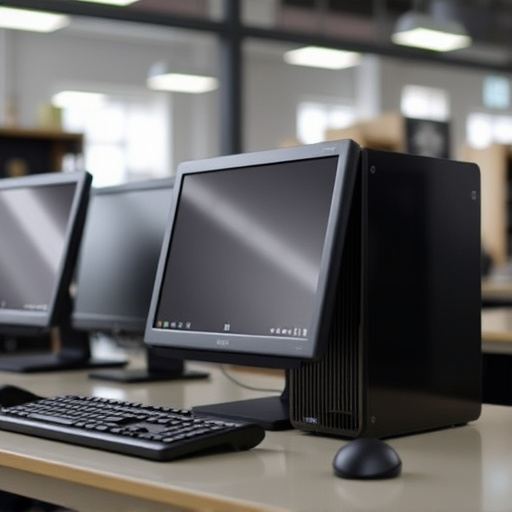Refurbished computers provide a sustainable, cost-effective solution for consumers seeking high-quality devices. With savings up to 50%, these pre-owned machines reduce electronic waste and promote a greener digital future. The meticulous refurbishment process ensures top performance and reliable warranties, surpassing potential quality inconsistencies of used devices. By choosing refurbished over used, consumers not only save money but also contribute to a circular economy, minimizing environmental impact and conserving resources.
Unsure about choosing between refurbished and used devices? This comprehensive guide breaks down the key differences to help you make an informed decision. We explore the benefits of refurbished computers, focusing on quality, performance, environmental impact, and cost-effectiveness.
Learn about the meticulous preparation processes that ensure top-notch refurbished devices, and discover why opting for refurbished can be an eco-friendly and financially smart choice.
- Understanding Refurbished Devices: What They Are and How They're Prepared
- Key Differences in Quality and Performance
- Environmental Benefits of Choosing Refurbished Over Used
- Cost Comparison: Analyzing the Financial Aspects and Value for Money
Understanding Refurbished Devices: What They Are and How They're Prepared

Refurbished devices are like a fresh start for used electronics, offering a second chance to serve their purpose while providing significant benefits to consumers. These devices have been previously owned and returned, or taken in by manufacturers as part of trade-in programs. They undergo a meticulous process where they’re inspected, repaired, restored, and tested to meet specific standards. This preparation ensures that refurbished computers function just like new ones, delivering top performance without the hefty price tag associated with brand-new models.
The benefits of refurbished computers are numerous. They offer cost savings of up to 50% or more compared to their brand-new counterparts, making them an attractive option for budget-conscious buyers. Additionally, they help promote sustainability by reducing electronic waste and conserving valuable resources needed for manufacturing new devices. Furthermore, refurbished devices often come with warranties, ensuring peace of mind for purchasers who can trust that their investment is backed by support from either the original manufacturer or a reliable reseller.
Key Differences in Quality and Performance

When comparing refurbished devices to used ones, one of the most significant aspects to consider is quality and performance. Refurbished devices often come with a renewed warranty, ensuring consumers receive a product that meets specific quality standards. This warranty can provide peace of mind, knowing that any defects or issues will be addressed promptly. Moreover, many reputable refurbishers employ skilled technicians who thoroughly inspect, test, and repair the hardware, leading to improved reliability and performance.
In contrast, used devices might not have undergone such rigorous testing or repairs, potentially resulting in inconsistent quality and performance. Without a warranty, buyers run the risk of purchasing a device with hidden problems that could arise post-purchase. However, it’s worth noting that used devices can offer significant cost savings, making them an attractive option for budget-conscious consumers. The benefits of refurbished computers lie in their balance between affordability and guaranteed quality, bridging the gap between price and reliability.
Environmental Benefits of Choosing Refurbished Over Used

Choosing refurbished devices over used ones offers significant environmental benefits, contributing to a greener digital future. The process of refurbishment involves repairing and restoring devices to like-new condition, reducing the demand for new hardware production. This, in turn, cuts down on resource extraction, manufacturing emissions, and energy consumption associated with creating new electronics. By opting for refurbished computers, consumers can lessen their carbon footprint and contribute to a circular economy where products are reused and recycled efficiently.
Moreover, refurbished devices often have a lower environmental impact than used ones. Used electronics may contain hazardous materials that, when improperly disposed of, can contaminate soil and water sources. Refurbished items, however, undergo thorough cleaning, testing, and quality assurance to ensure they meet safety standards, minimizing the risk of such environmental hazards. This eco-friendly approach not only protects natural resources but also promotes a more sustainable and responsible way of consuming technology.
Cost Comparison: Analyzing the Financial Aspects and Value for Money

When comparing refurbished versus used devices, cost is a primary consideration. One might assume that used items are always cheaper, but this isn’t necessarily true, especially when examining the benefits of refurbished computers. While used devices offer significant price cuts, refurbished products often provide better value for money due to their meticulous restoration process. Reputable refurbishers inspect, repair, and test each device, ensuring it meets specific performance standards.
This attention to detail means that customers can expect a reliable product without the potential risks associated with buying used. Refurbished computers often come with warranties, further assuring buyers of their investment’s longevity. Moreover, comparing like-new devices from reputable sources shows that refurbished options can be more cost-effective, offering performance and peace of mind at a competitive price point.
When considering a refurbished or used device, understanding the key differences can help you make an informed decision that best suits your needs. While both options offer financial advantages, refurbished devices stand out for their enhanced quality assurance, environmental sustainability, and significant cost savings without compromising performance. The benefits of refurbished computers extend beyond economic value, making them an eco-friendly choice that contributes to a circular economy.
